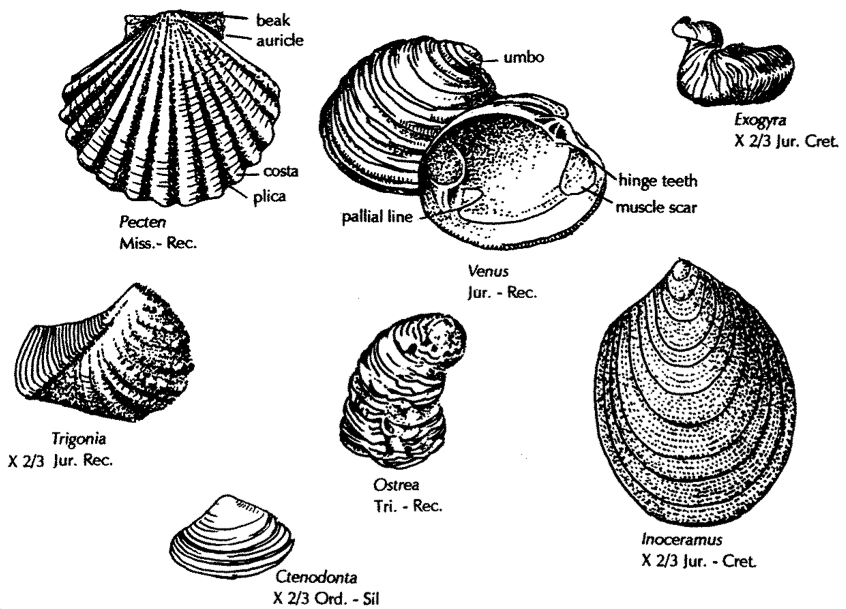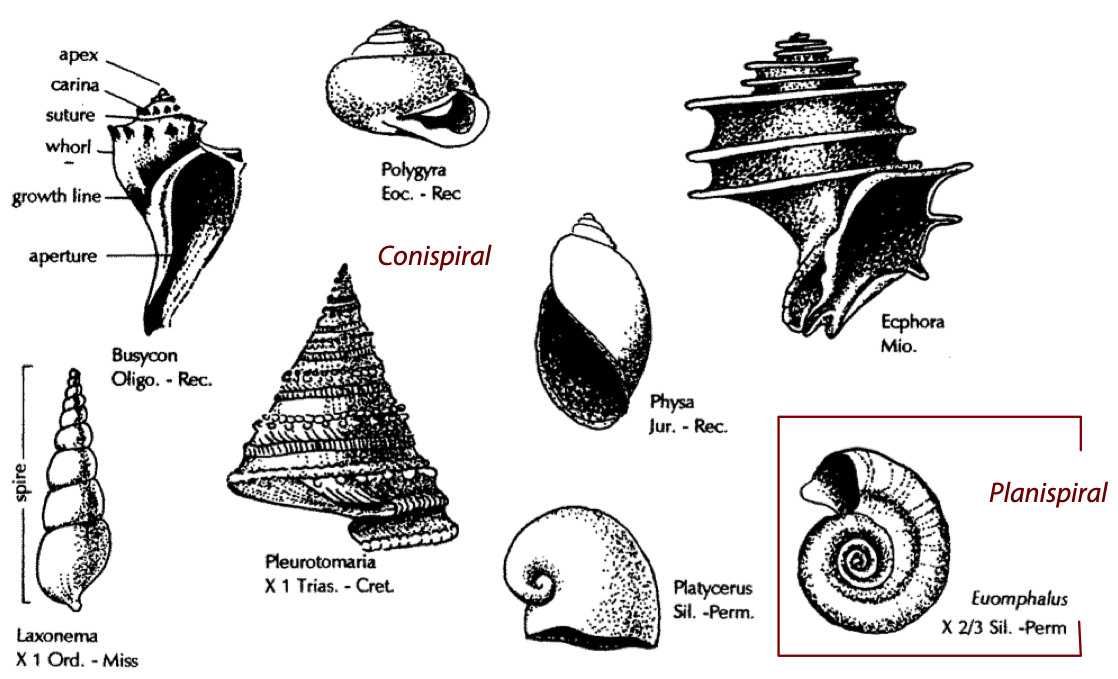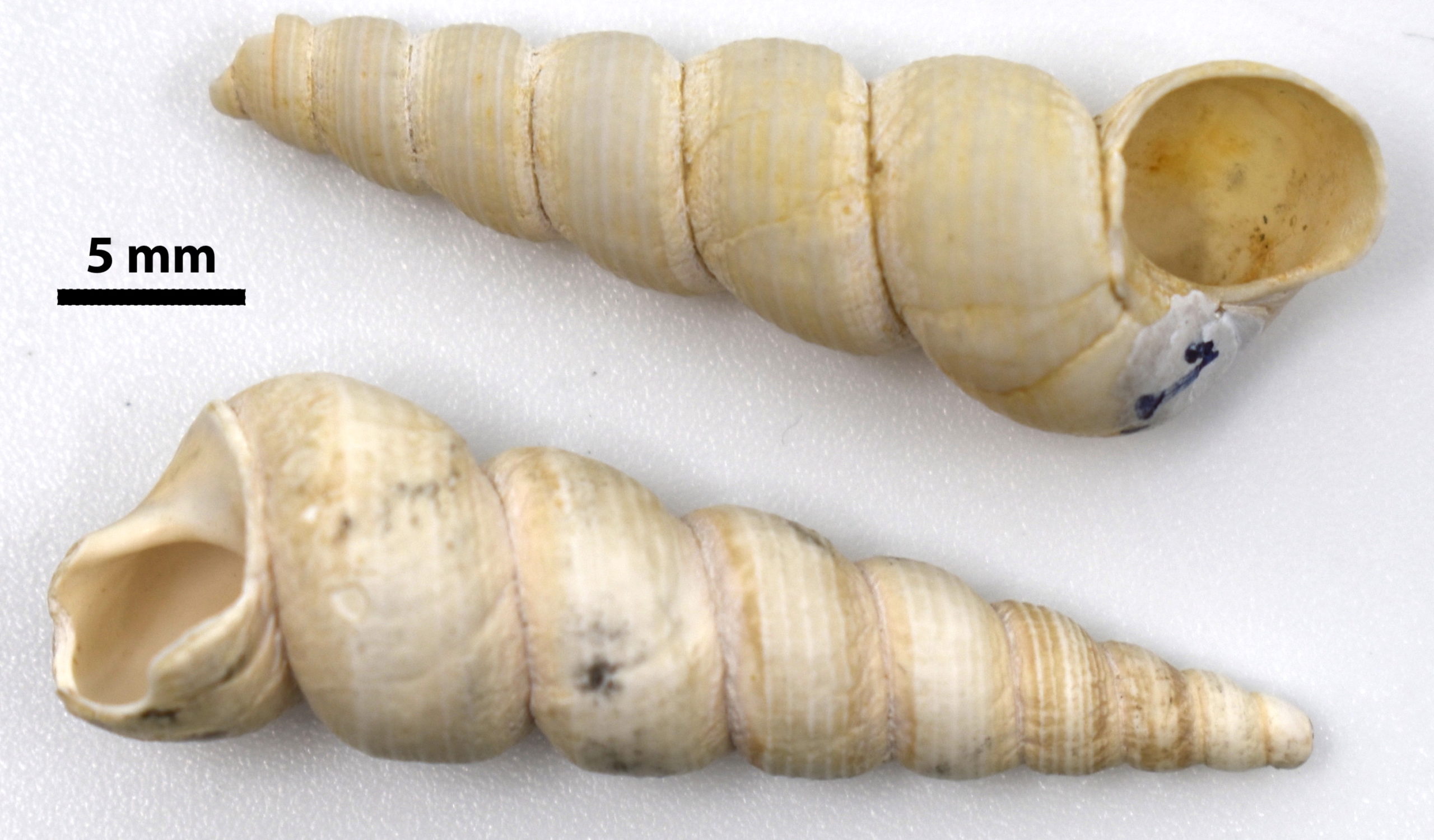Fossils of the Paleozoic: Phylum Mollusca (The Bivalves & Gastropods)
Phylum Mollusca includes several different types of animals with very different life habits and functions in the ecosystem. Being able to distinguish these different types is important, and so we will be examining three major classes of Phylum Mollusca: Class Bivalvia (the bivalves), Class Gastropoda (the gastropods, or snails) and Class Cephalopoda (cephalopods, including squid, octopi, nautilus and the extinct ammonites).
Members of Class Cephalopoda are very different from the slow-moving members of Class Bivalvia and Class Gastropoda; these alert, aggressive predators are strong swimmers with keen eyesight, and able to compete with marine vertebrates. As a class they attained the largest physical size of all the invertebrates. We will learn more about them in Lab 8. In today’s lab we will focus on Classes Bivalvia and Gastropoda.
Class Bivalvia (Includes Clams & Oysters)
Class Bivalvia ranges from Lower Cambrian to today, and peaked in the Cenozoic. Bivalve animals are typically encased in two shells—also called valves—hence the name bivalve. The shells have bilateral symmetry from top to bottom (the two shells look the same), rather than the side-to-side symmetry of the brachiopods (Figure 7.10).

Bivalves feed by sweeping food out of the water column and drawing it through the shell; for most bivalves this food is phytoplankton. Unlike brachiopods, the animal uses powerful muscles to hold the shells together, so upon death the two valves usually fall apart and are most often preserved as separate shells.
Another difference between bivalves and brachiopods is that bivalves lack the small opening at the hinge for a pedicle. Instead, they move about by extending a “foot” between their valves. Some bivalves attach themselves to the ocean bottom and may form large masses or banks. Others burrow into wood pilings or mud close to shore. Bivalve shells take many different forms that reflect the characteristics of the environment in which they lived, and they are easily preserved. This class is the most important index fossil for the Paleozoic, Late Mesozoic and most of the Cenozoic.
Questions a & b
a. What energy would epifaunal bivalves experience in comparison to infaunal bivalves?
b. What effect might this have on shell characteristics of the two life habits?
A. Sample 30: Modern Clam Shells
This sample can be picked up but please treat it with care.
Question c
B. Sample FFA18: Large Bivalve Shell
This sample can be picked up but please treat it with care.
Questions d-g
d. Identify the growth rings on the shell. What could these rings tell us about the environment in which this animal lived? Think about the environmental conditions that would make a clam happy versus what would stress the animal.
e. Describe the sedimentary rock that formed inside the shell. (See the last slide for a close-up view, or use a hand lens if you have access to the physical sample).
f. If the shell weathered away and this brown sedimentary material was left behind, what kind of fossil would this be? (Click here to review information about types of fossils in Lab 5.)
g. How does this sample’s symmetry differ from that of Samples 13, 9, and 15? Click here to see these samples again.
Class Gastropoda (Snails)
Class Gastropoda ranges from the Cambrian to today (no peak). Many marine gastropods move across the ocean floor and scrape algae off the sediments or rocks. Others are sediment deposit feeders and some are carnivores.
Gastropods share some similarities with clams, but they are more advanced. They have a distinct head with eyes, feelers, and a mouth with a rasp-like tongue.
In most gastropod species the shell is coiled and consists of only one unchambered valve (Figure 7.11), but some have uncoiled valves. Others, like the garden slug, that have no valve at all. Gastropods can have shells with conispiral or planispiral coils, but in this course we examine only on gastropods with conispiral coiled shells (Click here to review coiling from Lab 5).

Gastropods are common index fossils for the Late Mesozoic and most of the Cenozoic because they are abundant in the fossil record, have varied and easily identifiable forms, and their shell characteristics reflect their living environment.
Question h
C. Sample 1: Modern Gastropod Shells
These samples can be picked up but please treat them with care.
Question i
D. Sample FL3: Pleistocene Gastropod Shells (within the last 1.8 MY)
These samples can be picked up but please treat them with care.
Questions j & k
j. What type of coiling do these samples demonstrate?
k. Parts of the outer shells of Sample FL3 have been eroded away and the infilled sediment is visible. Are these shells chambered?
E. Sample 21: Gastropod Shells
These samples can be picked up but please treat them with care.
Question l

